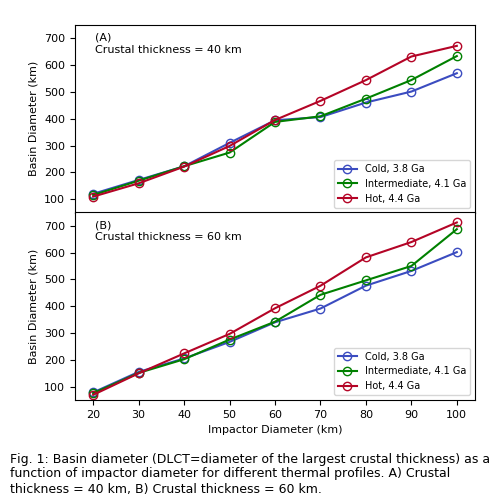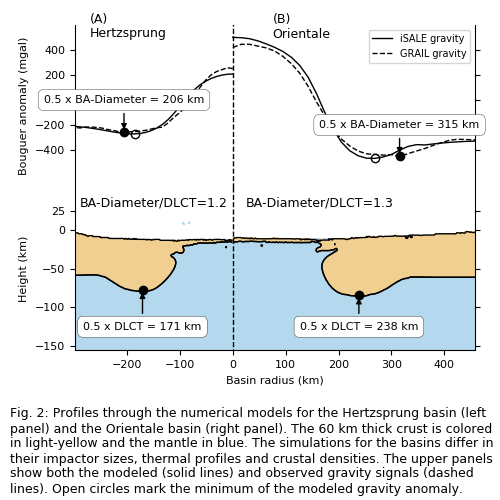Numerical modeling of farside impact structures on the Moon constrained by gravity data
- 1Museum für Naturkunde - Leibniz Institute for Evolution and Biodiversity Science, FB 1, Berlin, Germany (tomke.lompa@mfn.berlin)
- 2Freie Universität Berlin, Institute of Geological Sciences, Berlin, Germany
- 3Curtin University, Space and Science Technology Centre, School of Earth and Planetary Science, Perth, Australia
- 4Technische Universität Berlin, Institute of Planetary Geodesy, Berlin, Germany
- 5Institute of Planetary Research German Aerospace Center, Berlin, Germany
Introduction: The lunar surface is characterized by large impact basins that formed in the early history of the Moon. To better understand how basin size and their corresponding gravity signature are related to the impactor size and the thermal history of the Moon, we investigated how properties of impactor and target could affect this formation process. Impactor properties are defined by its size, density, and impactor velocity. The target is characterized by the crustal thickness and the thermal state. Previous studies (e.g.[1],[2],[3],[4]) revealed that thermal conditions in crust and mantle rocks affected the crater formation process, the final basin structure, and the gravity signature. Here, we present numerical simulations for 16 basins located on the lunar farside. The simulations are constrained by gravity data from the Gravity Recovery and Interior Laboratory (GRAIL) mission, and differ in impactor size, crustal thickness and target temperature as a function of depth. We established a relationship between the observed gravity, the geometry of the basin and the pre-impact thermal conditions of the target. These observations lead to a better understanding on how the thermal evolution of the Moon is related to changes in the formation of basins.
Methods: We used the iSALE2D shock physics code to simulate the basin formation process ([5],[6],[7],[8]). We used impactor sizes of 20km to 100km in diameter. The impactor speed was set to 13km/s. The resolution of all models was set to 25 cells per projectile radius (grid cell sizes from 400m to 2000m). The target was composed of a basaltic crust on top of a dunitic mantle. We changed the target properties by using two different crustal thicknesses (40km, 60km) and three temperature profiles which represent the Moon’s thermal states at 4.4, 4.1, and 3.8 billion years ago [9]. Gravity data from GRAIL mission [10] provides detailed information about the deep structure of lunar basins. By combining the most recent GRAIL gravity model GL1500E [11] with LOLA derived topography [12], we obtained a highly resolved Bouguer gravity field.
We assumed constant densities in both crust and mantle to calculate Bouguer gravity anomalies from the basin formation models. This approach can be understood as a simple way to mimic the density distribution after a long-term cooling process in the basin. The shape of the gravity signal preserves information about the position of the crust-mantle boundary and, therefore, assuming constant densities is useful in order to verify the geometry of the model.
Results: For all 54 models we determined the diameter of the largest crustal thickness (DLCT) as a measure of the size of the basins. Figure 1 shows the relationship between impactor sizes and the DLCT for different temperature profiles and initial crustal thicknesses. The results show similar basin diameters for small impactors independently from the thermal profile. For impactor sizes larger than 40km (Fig.1A) or 30km (Fig.1B), the diameters of the hotter profile are significantly higher than those of the cold and intermediate profiles.

We present Hertzsprung and Orientale basin as two examples for gravity modeling. In the formation model of Hertzsprung (Fig. 2A), we used the thermal profile corresponding to an age of 4.1Ga [13]. Figure 2 shows our best-fit model assuming an impactor size of 60km, and a crustal density of 2950kg/m3. The results for Orientale are shown in Figure 2B. In the best-fit model the impactor is 80km in diameter, crustal density is 2750kg/m3 and we assume a cold thermal profile corresponding to an age of 3.8Ga [13]. Gravity profiles from the formation models show that the position of Bouguerminima correlate with the DLCT. The ratio of Bouguerdiameter and DLCT evaluates the fit of the models. A ratio of one indicates that the Bouguerminimum is close to the DLCT.

Conclusion: Our results agree with previous studies [4] in terms of the importance of the thermal state of the target material. Final crater morphologies are sensitive to the thermal conditions in the target material. In our study, temperature effects are visible in simulations with impactors larger than 40km and the change from intermediate to hot thermal states. Isostatic relaxation processes might further modify the initial gravity signature over time. The correlation between basin size and the position of the minimum in observed gravity is a powerful tool to predict impactor diameters without extensive modeling studies.
Acknowledgments: We gratefully acknowledge the developers of iSALE. Topography and gravity data are available at NASA’s PDS. This work is funded by the DFG-grant SFB-TRR 170 (A4). Katarina Miljković research is funded by the Australian Research Council.
References: [1]Ivanov, B., Melosh, H., and Pierazzo, E. (2010) Large Meteorite Impacts and Planet. Evol. IV,29-49. [2]Potter, R. W. K. et al. (2013) JGR:Planets,118,963-979. [3]Zhu, M.-H., Wünnemann, K. and Potter, R. W. K. (2015) JGR:Planets,120,2118-2134. [4]Miljković, K. et al. (2016) JGR:Planets,121,1695-1712. [5]Collins, G. S., Melosh, H. J. and Ivanov, B. A., (2004) Meteoritics & Planet.Sci.,39,217-231. [6]Wünnemann, K., Collins, G. and Melosh, H. (2006) Icarus,180,514- 527. [7]Thompson, S. L. (1990) Sandia National Laboratories Albuquerque, SAND89-2951. [8]Melosh, H. J. (2007) Meteoritics & Planet.Sci.,42,2079–2098. [9]Padovan, S. et al. (2018) EPSC,Abstract#755. [10]Zuber, M. T. et al. (2013) Science,339,668-671. [11]Park, R. S. et al. (2015) AGU Fall Meeting,Abstract#G41-B01. [12]Smith, D. E. et al. (2017) Icarus,283,70-9. [13]Orgel, C. et al. (2017) JGR:Planets,123,1-15.
How to cite: Lompa, T., Wünnemann, K., Miljković, K., Wahl, D., and Padovan, S.: Numerical modeling of farside impact structures on the Moon constrained by gravity data, Europlanet Science Congress 2020, online, 21 Sep–9 Oct 2020, EPSC2020-305, https://doi.org/10.5194/epsc2020-305, 2020.

